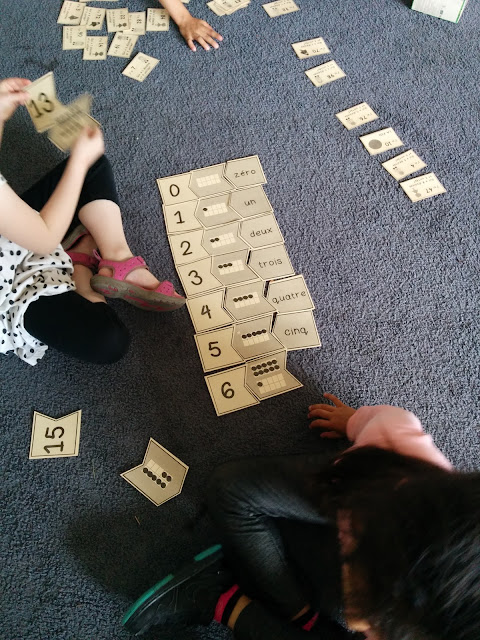The kids continue to work on the stories they planned earlier. Daily 5 has been going very well, with a lot of focused reading taking place. The kids are motivated because they see me reading individually with every kid to assess their reading level for the end of the school year.
In math we focused on better understanding place value. Place value is the idea that where a digit is located in a given number determines the value that digit represents. For example, the "8" in 18 represents 8 but the "8" in 81 represents 80. We started off with counting a pile of pennies, grouping them into piles of 10. We counted by 10's until we ran out of piles, and then we added on the last remaining pennines 1 by 1. I introduced the vocabulary of "tens" and "ones" (dizaines and unités in French) in relation to our counting. The next day I switched the 64 with the 46 on our hundred chart. I asked the kids if they noticed anything peculiar, and when they did I acted as if it was no big deal because both numbers had a 6 and a 4. I asked them to explain what the difference was if the 4 was in the spot on the right or the spot on the left. Many kids have developed an intuitive understanding of this distinction, but they had trouble articulating it. We finally got around to the idea that when the 4 was on the right, it meant 4 "unités" and when it was on the left it meant 4 "dizaines".
The kids did a partner activity to practise the concept. One partner chose 2 number tiles and put them together. The other partner had to show that number using base 10 blocks, in tens and ones, on a place value mat. Then the first partner switched the numbers around and the first partner had to represent the new number. Then they changed roles.
I also introduced 5 new centres that focus on numeracy, for the last month of school. After explaining each centre through the week, we finally did them all on Friday. The above activity with base 10 blocks is one centre. Another has kids grab a pile of pennies, estimate how many there are, and then put them into groups of 10 to count.
Another centre has 2 card games: one asks kids to match the number with the ten frame and with the number word; the other is a version of "I have...who has" where a kid might read their card saying "Who has 3 tens and 2 ones?" and another would read their card saying "I have 32! Who has 7 tens and 6 ones?"
Another centre has kids using a special balance to write balanced equations:
Since the balance is a 2 person activity, the other 2 people do an activity with dice. They roll 2 dice, and write the numbers as a 2-digit number in the middle box on a sheet. Then they write the number that comes before and the number that comes after in the counting sequence.
The last centre is for practicing the "Friendly 10" strategy for adding (also useful for subtraction). Kids work independently, and fill in the blanks on a worksheet. First they roll 2 numbers from the possibilities of 5, 6, 7, 8, or 9. Say they roll 6 and 6. They write these numbers on the sheet, and fill two adjacent ten frames to represent the numbers. Then they move the counters from one ten frame to fill the other ten frame. This makes a ten with remaining counters. The sheet then asks them to fill in 10 + __ and then asks for the answer, which is now made easy because it is adding a single digit to 10.
The kids really enjoyed the novelty of the new centres, so hopefully that won't wear off too soon!









No comments:
Post a Comment